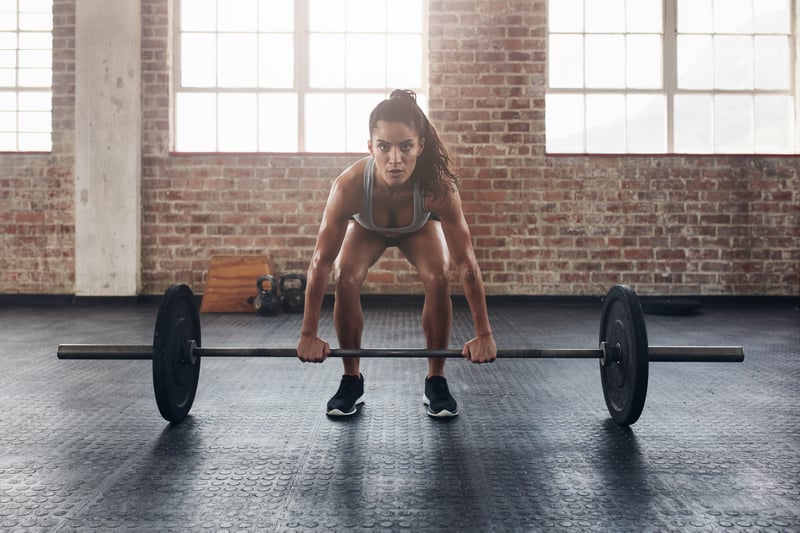How to Do a Deadlift at Any Fitness Level (with Perfect Form)

If you’ve been in the fitness arena for any period of time, chances are good you’ve heard of deadlifts and may have even wondered how to do a deadlift. The good news is that you can learn how to do a deadlift at any fitness level with perfect form.
What is a Deadlift?
A deadlift is what’s known as a “compound” exercise, meaning it works multiple muscle groups when executed. It is an exercise you’ll find as part of a good resistance training program and involves lifting a barbell or dumbbells from a bent-over position upward until your back and arms are straight. You may lift the weight from the floor or, depending on the style of deadlift you’re performing, you might lift it from a rack. One of the three powerlifting exercises (deadlift, squat, and bench), the deadlift mainly targets the muscles of the legs and back, with secondary attention on the arms.
Why Are Deadlifts Important?
Deadlifting is one of those phenomenal exercises that just about everybody can (and should) be doing. The benefits of doing deadlifts are numerous. Where to start… It can help:
- Strengthen your back—keeping your pelvis stable is a big job, and this is where your glutes come into play. A stable core and booty are part of the “girdle” that keeps your body stabilized and strong.
- Create a strong posterior chain—the muscles in your back and legs get thoroughly worked with deadlifting exercises, and this helps strengthen not only your core but your entire posterior chain, which is comprised of the glutes, hamstrings, erector spinae, traps, and rear portion of the shoulders.
- You look great in jeans—there’s just something special about a toned physique, and doing deadlifts can help you get that. You’ll strengthen and tone, of course, but this exercise can also help you build some coveted shape to your backside and legs.
- Avoid injury—by strengthening your muscles and core and building the muscles along the back of your body, you can help correct potential imbalances that could lead to injury.
- You become a better athlete—a strong core and powerful posterior chain will help you become stronger across the board in sporting activities.
- Burn those calories—deadlifting will help you add metabolically active muscle tissue which, in turn, will help you burn off extra calories all day, every day.
How to Do a Deadlift Properly
Start with a weight that is light enough for you to get the hang of the motion and do it with proper form before progressing to heavier weights. Learning proper form is the most important thing you can do.
If using a barbell, make sure the weights are secured on the bar (you may need to use clips). Stand with your feet midway under the bar and your feet hip-width apart or slightly wider. Your toes can be pointed slightly outward if this is more comfortable for you. Squat down and “sit back” (as if you were going to sit in a chair) while grabbing the bar with your palms facing you. Your hands should be just outside your knees. When bending and straightening, your knees should track directly over your feet (don’t let them drift inward or too far outward).
Once you’re set up, slowly begin to straighten your back and arms until you feel tension from the weight of the bar. This is your starting position. Puff your chest out, keep your head up and your back straight, and slowly stand upright. Push through your heels as you stand and thrust your hips forward. The bar will likely scrape along the front of your legs as you straighten. Don’t worry, you’re doing it right! Keeping your shoulders back, straighten until you’re fully upright, and squeeze your leg and glute muscles as you do so. Hold this squeeze for a moment before beginning to lower the bar.
To lower the bar, push your hips back (again, as if you were about to sit on a chair). Keep your back flat and your shoulders back as you lower the bar to the starting position. Make sure to let it drag down your shins again on the way down to ensure the bar is not too far away from your body as improper form here could strain your back.
5 Deadlift Variations You Should Be Doing
- Standard Deadlift—to perform a regular deadlift, you’ll do all the movements mentioned above.
- Romanian Deadlift—this is also very similar to the standard deadlift except that you’ll keep your legs straighter instead of fully bending at the knees and squatting. Make sure to push your hips backwards as you lower the weight and then thrust them forward and squeeze as you straighten.
- Kettlebell Straight-Legged Deadlift—begin by standing with your feet about hip-width apart. Grasp a kettlebell with both hands and let your arms hang straight down in front of you, but keep your shoulders back (don’t let them roll forward). While keeping your legs and back straight, push your hips backwards, and bend forward at the waist to lower the kettlebell toward the ground. Get a good stretch through your hamstrings and pause for a moment before pushing your hips forward again and straightening your upper body back to the standing position.
- Single Leg Dumbbell Deadlift—for this exercise, you’ll start with a dumbbell in each hand. Begin by standing with your feet hip-width apart. Bend at the waist and let your straightened arms move toward the ground as you lift your right leg straight out behind you until your leg and torso are parallel to the ground. Pause at the top of the movement, and then bring your right leg forward and down again to the starting position. Repeat ten times on the right side, and then duplicate on the left.
- Sumo Deadlift—no, you aren’t going to get the hind end of a Sumo wrestler if you do this style of deadlift! Quite the opposite in fact. These are another wonderful way to target the glutes. Begin by setting your feet under the bar, wider than hip-width apart with your toes pointed outward. Turn your legs so your knees and thighs track outward over your toes. Bend at the knees first while allowing your hips to push back naturally as you lower your body and grasp the bar. Your elbows will be inside of your knees. Push through your heels to help you lift the bar. Return to the starting position by bending the knees and keeping the glutes relatively high until the bar is back on the ground.






